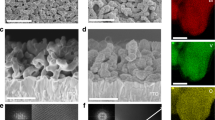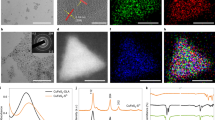Abstract
SEMICONDUCTING electrodes stable in aqueous solution during the photoelectrochemical oxidation of water have generally been large-bandgap oxides, and their photosensitisation to visible light is of continuing interest1. In particular, n-type TiO2 (rutile, with a bandgap of 3.0 eV) is a stable photoanode for the photoelectrolysis of water by uv light2, and considerable effort has been devoted to its photosensitisation to sunlight1. One approach to photosensitisation is the use of a dye that, on excitation by visible light, transfers an electron to the conduction band of the solid and subsequently returns to its reduced ground state by the oxidation of water. The three major problems to be avoided are (1) irreversible degradative oxidation of the dye3, (2) failure of the oxidised form of the dye to oxidise water, reduction being carried out by a supersensitiser, such as hydro-quinone, that is consumed by the reaction4,5, and (3) inefficient electron transfer from the dye to the solid6. To circumvent the first two of these problems, we have selected an inorganic complex as the dye, a derivative of [Ru(BIPY)3]2+ (BIPY = 2,2′-bipyridine). [Ru(BIPY)3]3+ is known to oxidise water in suitable pH conditions evolving about 80% of the theoretical yield of oxygen7. The last problem was avoided by chemically attaching the complex to the electrode surface, a procedure recently demonstrated for organic dyes (such as rhodamine-B) that require the use of a supersensitiser4,5. We report here that a single-crystal n-type TiO2 electrode, chemically modified by the attachment of a monolayer of a derivative of [Ru(BIPY)3]2+, will produce significant anodic photocurrents when irradiated with visible light in the absence of a supersensitiser.
This is a preview of subscription content, access via your institution
Access options
Subscribe to this journal
Receive 51 print issues and online access
$199.00 per year
only $3.90 per issue
Buy this article
- Purchase on Springer Link
- Instant access to full article PDF
Prices may be subject to local taxes which are calculated during checkout
Similar content being viewed by others
References
Rajeshwar, K., Singh, P. & DuBow, J. Electrochim. Acta 23, 1117–1144 (1978).
Harris, L. A. & Wilson, R. H. A. Rev. Mater. Sci. 8, 99–134 (1978).
Maruska, H. P. & Ghosh, A. K. Solar Energy 20, 443–458 (1978).
Osa, T. & Fujihira, M. Nature 264, 349–350 (1976).
Fujihira, M., Ohnishi, N. & Osa, T. Nature 268, 226–228 (1977).
Gerischer, H. & Willig, F. Topics curr. Chemistry 61, 31–84 (1976).
Creutz, C. & Sutin, N. Proc. natn. Acad. Sci. USA 72, 2858–2862 (1975).
Sprintschnik, G., Sprintschnik, H. W., Kirsch, P. P. & Whitten, D. G. J. Am. chem. Soc. 99, 4947–4954 (1977).
Constable, E. C. & Seddon, K. R. (in preparation)
Hamnett, A., Dare-Edwards, M. P., Wright, R. D., Seddon, K. R. & Goodenough, J. B. J. phys. Chem. (in the press).
Demas, J. N. & Crosby, G. A. J. Am. chem. Soc. 93, 2841–2847 (1971).
Memming, R. & Schröppel, F. Chem. phys. Lett. 62, 207–210 (1979).
Memming, R. Farad. Disc. Chem. Soc. 58, 261–270 (1974).
Wright, R. D. (in preparation).
Author information
Authors and Affiliations
Rights and permissions
About this article
Cite this article
ANDERSON, S., CONSTABLE, E., DARE-EDWARDS, M. et al. Chemical modification of a titanium (IV) oxide electrode to give stable dye sensitisation without a supersensitiser. Nature 280, 571–573 (1979). https://doi.org/10.1038/280571a0
Received:
Accepted:
Published:
Issue Date:
DOI: https://doi.org/10.1038/280571a0
This article is cited by
-
Chemically modifying electrodes—a classical tool box
Journal of Solid State Electrochemistry (2024)
-
Molecular engineering of contact interfaces for high-performance perovskite solar cells
Nature Reviews Materials (2022)
-
Charge transfer between photosynthetic proteins and hematite in bio-hybrid photoelectrodes for solar water splitting cells
Nano Convergence (2015)
-
Advances in dye-sensitized solar cell
Chinese Science Bulletin (1997)
Comments
By submitting a comment you agree to abide by our Terms and Community Guidelines. If you find something abusive or that does not comply with our terms or guidelines please flag it as inappropriate.



